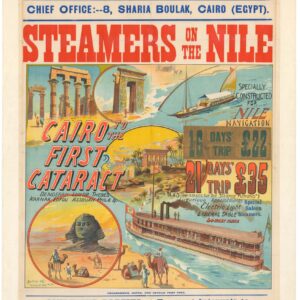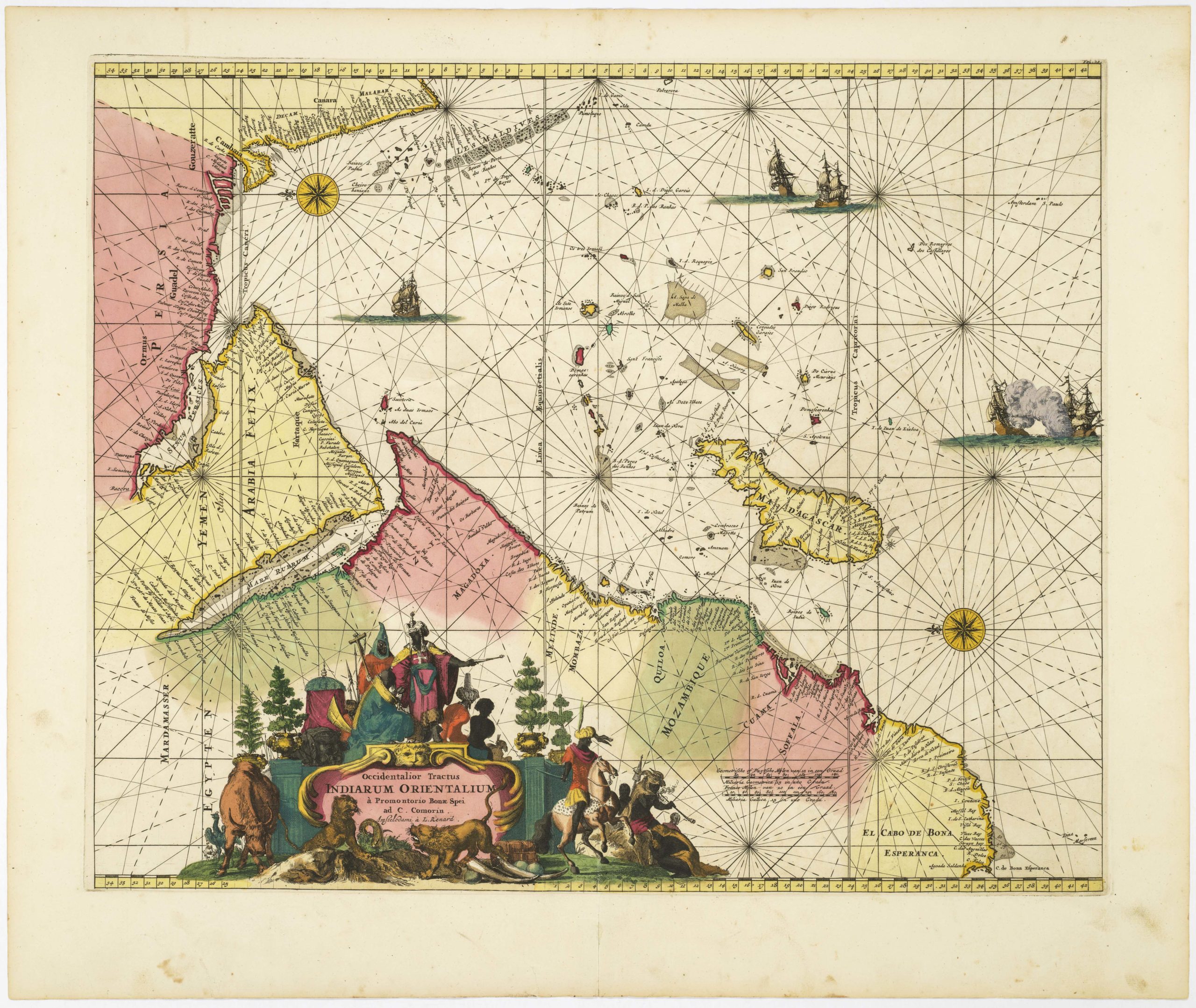Henry Salt’s scarce and important map of Abyssinia.
Map of Abyssinia and the adjacent districts laid down partly from original Observations taken in the Country and partly compiled from information collected there by Henry Salt…
Out of stock
Description
A beautiful and historically significant map of the Ethiopian Highlands from the early 19th century, compiled by one of Britain’s great pre-Victorian travelers, artists, and diplomats.
Details
This is Henry Salt’s fine map of early 19th century Abyssinia (greater Ethiopia). Salt was an English draughtsman and egyptologist whose skills as both a diplomat and artist caused him to visit the then remote region of Ethiopia on multiple occasions. Being among the day’s foremost British experts on the ancient Christian region of Abyssinia, Salt employed his talent as a draughtsman to produce this attractive and detailed map of an area largely unknown to British geographers at the time. We do not know whether the British government explicitly commissioned him or whether he received any formal training as a surveyor prior to his departure (although both are perhaps likely). However, what is clear from his map is that he built it on a seamless amalgamation of personal observations and the latest surveying principles. Clearly, Salt’s skills as a draughtsman and illustrator lost none of their luster when applied to the art of cartography, and his map quickly became the authoritative cartographic source for this region in the early 19th century.
The Abyssinian journeys of Henry Salt
Salt’s first journey to the region came in 1802 when he was appointed secretary and draughtsman to George Annesley Mountnorris, Viscount Valentia (a nobility title within the British peerage of Ireland), on his journey to India. The two men sailed with the British East India Company via the Cape, and en route Salt had the opportunity to explore the southern parts of the Red Sea and venture inland to visit the Ethiopian Highlands for the first time. He returned there in 1805 on a British government charge to engage in trade talks with the Tigray warlord Ras Wolde Selassie. Salt compiled numerous sketches, drawings, and paintings of the region and its people and customs during these initial visits.
Yet these works remained under the official charge of the viscount and were part of his expedition’s formal body of documentation. Essentially, this meant that Valentia owned the original artworks and the copperplates that were developed from them, and consequently, Salt’s evocative and beautiful illustrations were used to adorn the publication of their journey (Mountnorris & Salt 1809). Our map clearly shows that these conditions were based on mutual understanding and that Salt harbored no resentment towards his noble travel companion. In fact, despite having no direct relation to Viscount Valentia, Salt’s seminal map was dedicated to him in friendship.
Salt’s positive inclinations are perhaps unsurprising, as his experience with the Ethiopian interior and its peoples landed him a new British charge to travel to the region in 1809-10. Officially, he would again join an expedition to India, but in reality, he had been commissioned for a secret government mission to develop mercantile and diplomatic links with the new Ethiopian Emperor, Egwale Seyon. Whether it was this strategic dimension to his mission that caused him to think in cartographic terms and produce such a wonderfully evocative chart is not completely clear. While cartographically inclined travelers soon would become a well-known phenomenon of the Victorian Age, no Englishman had ever produced a map of the Ethiopian interior quite like this one before. Salt’s endeavor was, in this sense, not just extraordinary for his time but also heralded things to come. His visit would prove decisive for British interests, as he built on the experiences and contacts from his previous visits to expand the scope of British connections in the region.
Regardless of who might have come up with the idea, Salt’s experiences in Ethiopia led him to produce this detailed chart of the Abyssinian interior, which he later published in his personal travel accounts (1814). This volume was cram-packed with Salt’s observations and descriptions of his experiences, and the excitement of the text was beautifully enhanced by his vibrant illustrations of life in Abyssinia. The most enduring and important legacy from his journey was the map, which was expertly compiled and stood as the authoritative British map of the Ethiopian interior for decades. Because of the British patronage of Salt’s expedition, his map did more than simply expand the scope of geographical knowledge or frame the events of his account. It legitimized and substantiated any future British claims to the Southern Red Sea, should such claims become necessary (see context section below).
In addition to his travel account, which contained this map, Salt published a collection of drawings and watercolors entitled Twenty-four Views Taken in St Helena, The Cape, India, Ceylon, Abyssinia and Egypt. His efforts would not go unrewarded. The year after publishing his travels, Henry Salt was appointed British Consul to Egypt and moved to Cairo. From there, he mounted several important expeditions, including the one that would identify the great Ramesside temple of Abu Simbel (having been tipped off by Swiss traveler Johann Lewis Burckhardt). He also assembled an enormous collection of antiquities – primarily from Egypt and Ethiopia – which would later form the basis for the British Museum Egyptian collections and the Louvre. From his appointed exile in Egypt, Salt would revisit Ethiopia towards the end of his life.
Being of such extraordinary character and capacity, it seems fitting to end the description of Salt’s map with his own words, as they embody the spirit also embedded in the map itself:
“Among the different avocations to which men have devoted their time, no pursuits can lay perhaps a fairer claim to the Public favour than those of the traveller, owing to his efforts being generally directed to establish a more intimate connection between distant countries; thereby enlarging the bounds of knowledge, promoting the interests of commerce, and tending in a high degree to ameliorate the general condition of mankind”.
Henry Salt, 1814
Context is everything
Following the Napoleonic conquest of Egypt in 1798 and the initiation of the massive French study program for L’Description de la Egypte, the French also began exploring the possibility of (re-)establishing a navigable canal across the Suez Isthmus. The task was set for Napoleon’s best military engineers, and supposedly the emperor himself braved the Egyptian desert to inspect some of the ancient canal systems that would serve as the foundation for a new canal. It was, in other words, a tense period in European history and one in which the French-English struggle for world dominance began spilling over into the broader world. The French had secured Egypt, this was undeniable, but if the British could secure the southern half of the Red Sea by controlling Ethiopia, this would be almost as effective as controlling the canal itself.
Until this point, Ethiopia had been a relatively well-known geographic and even cultural entity, primarily due to its ancient Christianity. Yet only very few Englishmen had actually ventured this far inland. Cultivating relations here was crucial if the British were to gain a foothold in Northeast Africa, especially if vying for a potential connection between the Red Sea and the Mediterranean. But finding a suitable envoy for this vital yet strenuous task was not easy. Who could possibly be a good choice under these difficult conditions? Following the publication of the Viscount Valentia’s journey in 1804, it seems the British government had found their man.
Cartographer(s):
Henry Salt (14 June 1780 – 30 October 1827) was an English artist, traveler, collector of antiquities, diplomat, and Egyptologist.
After a time as a portrait painter, Salt traveled with the English nobleman George Annesley as his secretary and draughtsman. They started on an eastern tour in June 1802, traveling on the British East India Company’s extra (chartered) ship Minerva to India via the Cape Colony. Salt explored the Cape of Good Hope, India, and the Red Sea area.
In 1805, Salt journeyed into the Abyssinian area (now Ethiopia) to meet with Wolde Selassie, Ras of Tigray, to open up trade relations on behalf of the English. Salt returned to Ethiopia in 1809 on a government mission to develop trade and diplomatic links with the Ethiopian Emperor Egwale Seyon.
Condition Description
Bright, excellent example on thick paper. Minor blemishes and tape on verso along horizontal centerfold.
References
Source: Salt's 1814 A voyage to Abyssinia, and travels into the interior of that country, executed under the orders of the British government in the years 1809 & 1810.
BnF Identifier: ark:/12148/btv1b53006724j
Mountnorris, G. A., & Salt, H. (1809). Voyages and travels to India, Ceylon, the Red Sea, Abyssinia, and Egypt, in the years 1802, 1803, 1804, 1805, and 1806. London: W. Miller.





